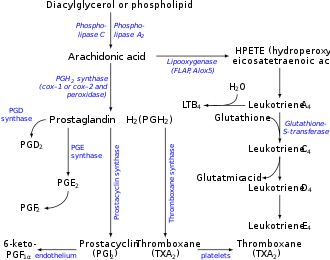Thromboxane A2
Thromboxane A2[edit]

Thromboxane A2 (TXA2) is a potent eicosanoid derived from the arachidonic acid pathway. It plays a crucial role in the hemostatic process by promoting platelet aggregation and vasoconstriction. Thromboxane A2 is synthesized in platelets and acts as a short-lived autocrine and paracrine signaling molecule.
Synthesis[edit]

Thromboxane A2 is synthesized from arachidonic acid, a polyunsaturated fatty acid, through the cyclooxygenase (COX) pathway. The enzyme cyclooxygenase converts arachidonic acid into prostaglandin H2 (PGH2), which is then transformed into thromboxane A2 by the enzyme thromboxane-A synthase. This process occurs primarily in platelets, which lack the ability to resynthesize nuclear DNA, making them reliant on the existing enzymes for thromboxane production.
Function[edit]
Thromboxane A2 is a key mediator in the hemostatic process. It induces platelet aggregation by activating the thromboxane receptor on the surface of platelets, leading to a cascade of intracellular events that result in the activation and aggregation of platelets. This is crucial for the formation of a hemostatic plug at sites of vascular injury.
In addition to its role in platelet aggregation, thromboxane A2 also causes vasoconstriction, which helps to reduce blood flow to the site of injury and minimize blood loss. This dual action of promoting platelet aggregation and vasoconstriction makes thromboxane A2 a vital component of the body's response to vascular injury.
Regulation[edit]
The activity of thromboxane A2 is tightly regulated in the body. Its synthesis is balanced by the production of prostacyclin (PGI2), another eicosanoid that has opposing effects. While thromboxane A2 promotes platelet aggregation and vasoconstriction, prostacyclin inhibits platelet aggregation and causes vasodilation. This balance is crucial for maintaining normal hemostasis and preventing excessive clot formation.
Clinical Significance[edit]
Thromboxane A2 is implicated in various pathological conditions, particularly those involving abnormal platelet activation and aggregation. Elevated levels of thromboxane A2 are associated with thrombotic disorders such as myocardial infarction, stroke, and peripheral artery disease.
Nonsteroidal anti-inflammatory drugs (NSAIDs), such as aspirin, inhibit the cyclooxygenase enzyme, thereby reducing the synthesis of thromboxane A2. This is why low-dose aspirin is commonly used as an antiplatelet therapy to prevent cardiovascular events in at-risk individuals.
Related Pages[edit]
| Eicosanoids | ||||||||||||||||||||||||||||
|---|---|---|---|---|---|---|---|---|---|---|---|---|---|---|---|---|---|---|---|---|---|---|---|---|---|---|---|---|
|
Ad. Transform your life with W8MD's Budget GLP-1 injections from $75


W8MD offers a medical weight loss program to lose weight in Philadelphia. Our physician-supervised medical weight loss provides:
- Weight loss injections in NYC (generic and brand names):
- Zepbound / Mounjaro, Wegovy / Ozempic, Saxenda
- Most insurances accepted or discounted self-pay rates. We will obtain insurance prior authorizations if needed.
- Generic GLP1 weight loss injections from $75 for the starting dose.
- Also offer prescription weight loss medications including Phentermine, Qsymia, Diethylpropion, Contrave etc.
NYC weight loss doctor appointmentsNYC weight loss doctor appointments
Start your NYC weight loss journey today at our NYC medical weight loss and Philadelphia medical weight loss clinics.
- Call 718-946-5500 to lose weight in NYC or for medical weight loss in Philadelphia 215-676-2334.
- Tags:NYC medical weight loss, Philadelphia lose weight Zepbound NYC, Budget GLP1 weight loss injections, Wegovy Philadelphia, Wegovy NYC, Philadelphia medical weight loss, Brookly weight loss and Wegovy NYC
|
WikiMD's Wellness Encyclopedia |
| Let Food Be Thy Medicine Medicine Thy Food - Hippocrates |
Medical Disclaimer: WikiMD is not a substitute for professional medical advice. The information on WikiMD is provided as an information resource only, may be incorrect, outdated or misleading, and is not to be used or relied on for any diagnostic or treatment purposes. Please consult your health care provider before making any healthcare decisions or for guidance about a specific medical condition. WikiMD expressly disclaims responsibility, and shall have no liability, for any damages, loss, injury, or liability whatsoever suffered as a result of your reliance on the information contained in this site. By visiting this site you agree to the foregoing terms and conditions, which may from time to time be changed or supplemented by WikiMD. If you do not agree to the foregoing terms and conditions, you should not enter or use this site. See full disclaimer.
Credits:Most images are courtesy of Wikimedia commons, and templates, categories Wikipedia, licensed under CC BY SA or similar.
Translate this page: - East Asian
中文,
日本,
한국어,
South Asian
हिन्दी,
தமிழ்,
తెలుగు,
Urdu,
ಕನ್ನಡ,
Southeast Asian
Indonesian,
Vietnamese,
Thai,
မြန်မာဘာသာ,
বাংলা
European
español,
Deutsch,
français,
Greek,
português do Brasil,
polski,
română,
русский,
Nederlands,
norsk,
svenska,
suomi,
Italian
Middle Eastern & African
عربى,
Turkish,
Persian,
Hebrew,
Afrikaans,
isiZulu,
Kiswahili,
Other
Bulgarian,
Hungarian,
Czech,
Swedish,
മലയാളം,
मराठी,
ਪੰਜਾਬੀ,
ગુજરાતી,
Portuguese,
Ukrainian